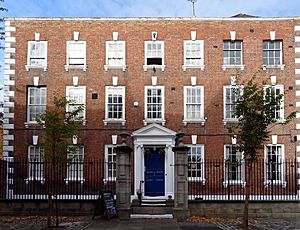Wool-stapler facts for kids
A wool-stapler was a special kind of merchant who dealt with wool. Think of them as the middle-person in the wool business! They would buy raw wool from farmers and sheep owners. Then, they would carefully sort and grade this wool based on its quality. After all that work, they would sell the prepared wool to people who made things like clothes or blankets.
Some wool-staplers became very rich from their trade. For example, Richard Chandler from Gloucester, England, was a wool-stapler who built a grand house called Winston Hall in 1750. This shows how successful some of these merchants could become.
Contents
What Was a Wool-Stapler?
A wool-stapler was a key person in the wool industry for many centuries. Their main job was to act as a dealer, connecting wool producers (like farmers) with wool manufacturers (like weavers). They made sure the right quality of wool went to the right buyers.
How Wool-Staplers Worked
The process involved several important steps:
- Buying: Wool-staplers would travel to farms or markets to buy large amounts of raw wool directly from the people who raised sheep.
- Sorting: Once they had the wool, they would carefully sort it. Wool from different parts of a sheep, or from different sheep, has different qualities.
- Grading: After sorting, they would grade the wool. This meant deciding its quality, such as how fine or coarse it was, and its color. This made it easier for manufacturers to buy exactly what they needed.
- Selling: Finally, they would sell the sorted and graded wool to manufacturers who would then spin it into yarn and weave it into cloth.
Understanding 'Staple' Markets
The word "staple" in "wool-stapler" has a special meaning. It refers to a market. Before the 1600s, a "staple" was a very specific type of market.
Royal 'Staple' Markets
A "staple" was a place chosen by the king or queen. In these special markets, a group of merchants had the only right to buy certain goods that were meant to be sold to other countries. This was often done to control trade and collect taxes.
The most famous English staple market was in Calais, a city that was once part of England. However, during the medieval times, there were many other staple markets. These markets were found throughout England, Ireland, and even in the Low Countries (like modern-day Belgium and the Netherlands). Many of these markets were involved in the important Medieval English wool trade.
Why the Term Changed
The term "wool-stapler" became less common over time. By the 1900s, the way wool was bought and sold changed a lot. New technologies and business methods meant that the specific role of a "wool-stapler" was no longer needed in the same way. The job evolved, and the old name slowly faded out of use.


